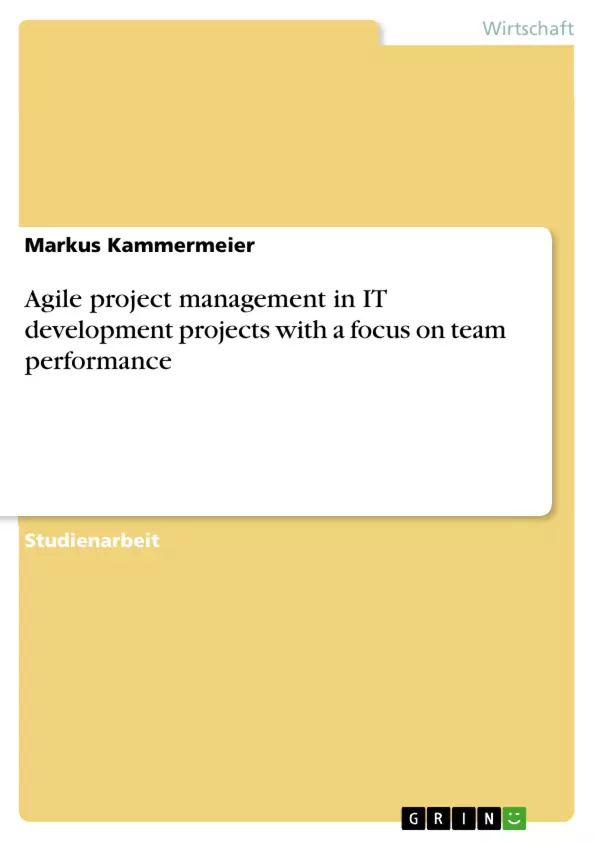Traditional, inflexible management is inefficient in product development projects: Project members feel uncomfortable and the result does not meet customer’s expectation. Therefore project management needs a kind of reorientation. The key success factors are the performance of the project team and the understanding of the customers’ needs. Therefore the main goal of today’s project management is to create the right environment for the project.
Agile project management promises to be a solution: It supports team performance and demands short project cycles. Short iteration and continuous feedback of the customers helps to stay on the right way and to adjust requirements if possible.
A popular example of agile project management is SCRUM. This study paper gives an overview about SCRUM itself. It presents roles, ceremonies and artifacts. It shows that SCRUM centers the team and the whole process is build around the team. The rules of SCRUM are simple and can easily be adapted. The focus of this paper is the roles of the process and how SCRUM supports team performance.
Inhaltsverzeichnis
- Management Summary
- Introduction
- Motivation
- Overview
- Intention
- Agile project management
- Basic concepts
- History
- Principles behind agile methods
- Scrum: An agile development process
- Overview
- Roles
- Product Owner
- Team
- Scrum Master
- Project manager in SCRUM
- Ceremonies and Artifacts
- Examples
- Perspective: Potential of SCRUM
- Bibliography
- List of Graphics
- List of abbreviations
Zielsetzung und Themenschwerpunkte
Dieses Studienpapier untersucht die Vorteile von agilen Projektmanagementmethoden, insbesondere Scrum, in IT-Entwicklungsprojekten. Der Schwerpunkt liegt auf der Verbesserung der Teamleistung und der Anpassungsfähigkeit an sich verändernde Anforderungen in einem schnelllebigen Umfeld.
- Grundlagen und Geschichte des agilen Projektmanagements
- Einführung in die Scrum-Methodik, einschließlich Rollen, Zeremonien und Artefakten
- Potenzial von Scrum zur Steigerung der Teamleistung und Verbesserung der Projektperformance
- Analyse der Auswirkungen von Scrum auf die Rolle des Projektmanagers
- Herausforderungen und Chancen bei der Implementierung von Scrum in IT-Entwicklungsprojekten
Zusammenfassung der Kapitel
- Management Summary: Die Zusammenfassung stellt das Problem der ineffizienten traditionellen Projektmanagementmethoden in der Produktentwicklung dar und hebt die Bedeutung agiler Ansätze wie Scrum hervor.
- Introduction: Dieser Teil bietet eine Motivation für das Studium des agilen Projektmanagements, gibt einen Überblick über die Thematik und definiert die Intention des Papiers.
- Agile project management: Kapitel 2 beschäftigt sich mit den grundlegenden Konzepten, der Geschichte und den Prinzipien hinter agilen Methoden.
- Scrum: An agile development process: In diesem Kapitel wird Scrum als ein agiler Entwicklungsprozess vorgestellt. Es werden die verschiedenen Rollen, Zeremonien und Artefakte von Scrum erläutert und die zentrale Rolle des Teams innerhalb des Prozesses hervorgehoben.
- Perspective: Potential of SCRUM: Kapitel 4 betrachtet die potentiellen Vorteile von Scrum und wie es zur Erfüllung von Projekt-Zielen beitragen kann.
Schlüsselwörter
Agile Projektmanagement, Scrum, IT-Entwicklung, Teamleistung, Projektperformance, Rollen, Zeremonien, Artefakte, Customer Feedback, Sprint, Product Owner, Scrum Master, Projektmanager.
- Quote paper
- Markus Kammermeier (Author), 2009, Agile project management in IT development projects with a focus on team performance, Munich, GRIN Verlag, https://www.grin.com/document/161147



